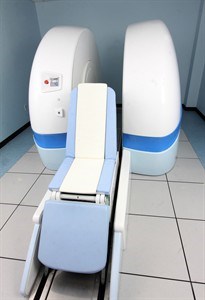
An Upright Open MRI machine is shown in this undated handout image. Lying still won't do it in this MRI machine, which allows people to sit, stand and squat so researchers can see their joints in action to possibly prevent hip osteoarthritis decades later. Biomedical engineer and University of British Columbia orthopedics professor David Wilson said there are about a dozen such Italian-made machines in the world but the one at Vancouver General Hospital is solely being used for research purposes. THE CANADIAN PRESS/HO - Centre For Hip Health and Mobility
July 02, 2014 - 4:45 PM
VANCOUVER - Lying still won't do it in this MRI machine, which allows people to sit, stand and squat so researchers can see their joints in action to possibly prevent hip osteoarthritis decades later.
Biomedical engineer and University of British Columbia orthopedics professor David Wilson said there are about a dozen such Italian-made machines in the world but the one at Vancouver General Hospital is solely being used for research purposes.
He said the other Upright Open MRIs, in the United Kingdom, Italy and mostly in the U.S., are for patients who are obese or so claustrophobic that they can't lie in the confines of a traditional MRI scanner.
Wilson, who is also a researcher at the Centre for Hip Health and Mobility, said people who have some hip pain because of a possible bone deformity and are between their 20s and 50s are part of a study to determine if such deformities eventually cause osteoarthritis.
"We had been looking around for a scanner that would give us more capacity to look at the joints where they're actually working so it's functional imaging of joints. You're not trying to take a picture, you're actually seeing how they work."
During the scan, patients are positioned so that the bony deformity, which is a bump, runs into the pelvis side of the hip joint as they move.
Researchers are trying to determine whether wear and tear over time causes pain and grinds away at the cartilage, leading to osteoarthritis.
"That's the big question, and that's what we're curious about."
Subtle bone deformities are believed to be prevalent in as much as 25 per cent of the population, Wilson said, adding younger people are having more hip pain, especially as the population becomes heavier.
The deformities have increasingly become an area of interest for researchers who believe they're responsible for the pain that develops into debilitating osteoarthritis as people become older.
"The reason that interest is so strong is because it used to be thought that hip osteoarthritis was just idiopathic, it just arose and there was no particular reason. You were just unlucky, you got hip osteoarthritis. Now we think that most of the cases are because of some kind of hip deformity and this is the big one that we're interested in."
About 140 patients will be scanned as part of the eight-year study as researchers monitor their pain and advise them on what activities they should or should not be doing to prevent hip problems.
Bone growth and development, not genetics, are believed to be responsible for the deformities, Wilson said.
The participants are part of a larger $2.5 million study that's been ongoing for three years, involves the Arthritis Research Centre of Canada and is funded by the Canadian Institute of Health Research.
A total of 1,100 research subjects are included in the overall study — 500 Caucasians, 400 aboriginals and 200 Chinese.
"We know that Chinese people in China have a very low incidence of hip osteoarthritis and we believe that aboriginals have a higher incidence of osteoarthritis," said Wilson, who is not part of that aspect of the study.
Dr. Gillian Hawker, osteoarthritis clinical research scientist at Women's College Research Institute in Toronto, said the MRI study is so important because it may potentially lead to new treatments such as drugs or exercise that could prevent the progression of the painful disease.
"We don't have anything right now that we know can prevent the development or the worsening of arthritis — nothing, other than weight loss," said Hawker, who is also chairwoman of medicine at the University of Toronto.
"There's no question that we have not paid much attention to this compared to the huge burden on our population. It is a huge issue."
News from © The Canadian Press, 2014